
Rip-Cut
™
Owner’s Manual
GUIDE D’UTILISATION
MANUAL DEL PROPIETARIO
ITEM# KMA2685
ARTÍCULO# KMA2685
ARTICLE# KMA2685
NK9035
Version 3 - 02/2019
www.kregtool.com • 800.447.8638

!
WARNING
When using electric tools, always follow the safety precautions below to reduce the risk of re, electric shock,
and personal injury. Read all these instructions before attempting to operate this product. SAVE THESE INSTRUCTIONS.
General Safety Guidelines
1) Work area safety
a) Keep work area clean and well lit. Cluttered or dark areas
invite accidents.
b) Don’t use power tools in a dangerous environment. Don’t
use power tools in damp or wet locations, or expose them
to rain.
c) Do not operate power tools in explosive atmospheres,
such as in the presence of flammable liquids, gases or dust.
Power tools create sparks that can ignite the fumes or dust.
d) Keep children and bystanders away while operating a
power tool. Distractions can cause you to lose control.
e) Make your workshop child proof. Use padlocks, master
switches, or remove starter keys.
2) Electrical safety
a) Ground electric tools. If the tool is equipped with a three-
prong plug, it must be plugged into a grounded three-hole
electri cal outlet. If the proper outlet is not available, have one
installed by a qualified electrician. Never remove the third
prong or modify the provided plug in any way.
b) Do not expose power tools to rain or wet conditions. Water
entering a power tool increases the risk of electric shock.
c) Do not abuse the cord. Never use the cord for carrying,
pulling or unplugging the power tool. Keep cord away
from heat, oil, sharp edges or moving parts. Damaged or
entangled cords increase the risk of electric shock.
d) Use a proper extension cord and make sure it is in good
condition. When using an extension cord, be sure to use one
heavy enough to carry the current your power tool draws. An
undersized cord causes a drop in line voltage resulting in
loss of power and overheating. Table 1 shows the correct
cord gauge to use depending on cord length and tool
nameplate ampere rating. If in doubt, use the next heavier
gage. The smaller the gauge number, the heavier the cord.
e) When operating electric tools, avoid body contact with
grounded or earthed surfaces such as pipes, radiators,
kitchen ranges, and refrigerators. Contact with a grounded
surface increases the risk of electric shock.
3) Personal safety
a) Stay alert, watch what you are doing and use common
sense when operating a power tool. Do not use a power tool
while you are tired or under the influence of drugs, alcohol
or medication. A moment of inattention while operating
power tools can result in serious personal injury.
b) Always wear safety glasses. Everyday eyeglasses are
not safety glasses. Safety glasses have specially constructed
lenses, frames, and side shields.
c) Use safety equipment. Use a face or dust mask when the
cutting operation is dusty. Safety equipment such as a dust
mask, non-skid safety shoes, hard hat, or hearing protection
used for appropriate conditions reduces personal injuries.
d) Avoid accidental starting. Make sure the switch is in the
off-position before plugging in. Carrying power tools with
your finger on the switch or plugging in power tools that
have the switch on invites accidents.
e) Remove any adjusting key or wrench before turning the
power tool on. A wrench or a key left attached to a rotating
part of the power tool can result in personal injury.
f) Do not overreach. Keep proper footing and balance at
all times. This enables better control of the power tool in
unexpected situations.
g) Secure workpieces. Use clamps or a vise to hold work
when practical. This is safer than using your hand and it
frees both hands to operate the tool.
h) Never stand on the machine. Serious injury can occur if
the tool tips or if the cutting tool is unintentionally contacted.
i) Dress properly. Do not wear loose clothing or jewelry. Keep
your hair, clothing and gloves away from moving parts.
Loose clothes, jewelry or long hair can be caught in moving
parts. Roll up long sleeves to the elbow. Wear protective hair
covering to contain long hair.
j) If devices are provided for the connection of dust extraction
and collection equipment, ensure these are connected and
properly used. Use of these devices reduces dust-related
hazards.
4) Power tool use and care
a) Keep guards in place and in working order.
b) Do not force the power tool. Use the correct power tool for
your application. The correct power tool will do the job better
and safer at the rate for which it was designed.
c) Use the right tool. Don’t force a tool or attachment to do a
job for which it was not designed.
d) Do not use the power tool if the switch does not turn it
on and off. Any power tool that cannot be controlled with the
switch is dangerous and must be repaired.
e) Disconnect the plug from the power source and/
or the battery pack from the power tool before making any
adjustments, changing accessories, or storing power tools.
Such preventive safety measures reduce the risk of starting
the power tool accidentally.
f) Never leave a tool running unattended. Turn power off.
Do not leave the tool until it comes to a complete stop.
g) Store idle power tools out of the reach of children and do
not allow persons unfamiliar with the power tool and
these instructions to operate the power tool. Power tools are
dangerous in the hands of untrained users.
h) Maintain power tools. Check for misalignment or binding
of moving parts, broken parts, and any other condition that
can affect power tool operation. If damaged, have the power
tool repaired before use. Many accidents are caused by
poorly maintained power tools.
i) Keep cutting tools sharp and clean. Properly maintained
cutting tools with sharp cutting edges are less likely to bind
and are easier to control.
j) Use the recommended speed for the cutting tool or
accessory and workpiece material.
k) Only use parts and accessories recommended by the
manufacturer. Consult the owner’s manual for recommended
accessories. Using improper accessories can cause personal
injury.
l) Use the power tool, accessories, and tool bits in
accordance with these instructions and in the manner
intended for the particular type of power tool, taking into
account the working conditions and the work to be
performed. Use of the power tool for operations different
from those intended can result in a hazardous situation.
5) Service
a) Have your power tool serviced by a qualified repair person
using only identical replacement parts. This ensures that the
safety of the power tool is maintained.
6) SAFETY INSTRUCTIONS SPECIFIC TO USING THE RIP-CUT
™
a) Before using the Rip-Cut
™
, read, understand,
and follow the safety warnings and operation
instructions included with this product and provided
by your saw manufacturer. Keep all guards and safety
devices in place.
b) Wear proper eye, ear, and respiratory protection when
operating your saw.
c) Use a sharp blade designed for the type of material you
are cutting.
d) Always disconnect your saw from power before making
adjustments to the saw or Rip-Cut
™
.

General Safety Guidelines
TABLE 1
Nameplate
Amperes
@120 V
Extension Cord Length
25' 50' 75' 100' 150' 200'
Recommended Wire Gauge
0 -5 16 16 16 14 12 12
5.1 - 8 16 16 14 12 10 NR
8.1 -12 14 14 12 10 NR NR
12.1 - 16 12 12 NR NR NR NR
NR – Not Recommended
WARNING:
!
This product can expose you to chemicals including Acrylonitrile
and other chemicals, which are known to the State of California to cause cancer and
reproductive harm. For more information go to www.P65Warnings.ca.gov.
e) Check the cursor alignment before you cut.
f) Ensure that the saw blade will not contact
the edge guide during the cut.
g) Do not attempt a cut when any part of the Rip-Cut
™
sled interferes with the operation of the saw blade guard.
h) Fully support both the workpiece and the cutoff piece
to prevent binding and kickback.
i) Adjust the depth of cut so the saw blade protrudes
1
⁄8" [3mm] through the workpiece during the cut.
j) Keep your hands away from the saw blade during
operation. Do not reach under the workpiece while cutting.
k) Secure your workpiece to ensure it doesn’t move
during the cut.
l) Do not use excessive force when cutting.
Maintain a steady and controlled pace.
m) Allow the saw blade to come to a complete stop
before lifting the Rip-Cut from your work piece.
n) Maintain your tools and accessories.
Check for misalignment or binding of moving parts,
loose fasteners, broken parts, and any other condition
that may affect safe operation. If an unsafe condition is
discovered, correct it before use.
7) Kickback
Kickback is a sudden reaction to a pinched, bound, or
misaligned saw blade, causing an uncontrolled saw to lift up
and out of the workpiece toward the operator.
8) Causes of kickback
a) When the blade is pinched or bound tightly by the kerf
closing in, the blade stalls and the motor reaction drives the
unit rapidly back toward the operator.
b) If the blade becomes twisted or misaligned in the cut,
the teeth at the back edge of the blade can dig into the top
surface of the wood causing the blade to climb out of the
kerf and propel the saw back toward the operator.
Preventing kickback
Kickback is the result of tool misuse and/or incorrect
operating procedures or conditions and can be avoided by
taking proper precautions.
a) Maintain a firm grip with both hands on the saw and
position your body and arms to resist kickback forces.
Kickback forces can be controlled by the operator if proper
precautions are taken.
b) When blade starts to bind, or when interrupting a cut for
any reason, release the trigger and hold the saw motionless
in the material until the blade comes to a complete stop.
Never attempt to remove the saw from the work or pull the
saw backward while the blade is in motion. Investigate and
take corrective actions to eliminate the cause of blade binding.
c) When restarting a saw in the workpiece, center the saw
blade in the kerf and check that saw teeth are not engaged
in the material. If the saw blade is binding, the blade may
climb out of the workpiece and kickback as the saw is restarted.
d) Support large panels to minimize the risk of blade
pinching and kickback. Large panels tend to sag under their
own weight. Supports must be placed under the panel on
both sides of the cut: near the cutline and near the edge of
the panel.
e) Do not use a dull or damaged blade. A dull or improperly
sharpened blade produces a narrow kerf, causing excessive
friction, blade binding, and kickback.
f) Blade depth and bevel adjusting locks must be tight and
secure before making a cut. If blade adjustment shifts while
cutting, it may cause binding and kickback.
g) Use extra caution when making a plunge cut into existing
walls, floors, or other blind areas. The protruding blade may
contact unseen objects that can cause kickback.
Guidelines for extension cord use
Extension cords are only to be used for temporary purposes.
They do not replace the need for installation of outlets and
proper wiring where necessary.
In the shop and on construction sites:
1. Extension cords with an equipment grounding conductor
must be used at all times.
2. Extension cords must be protected from damage, and not
run through doorways or windows where the doors or
windows can close, causing damage to the cord.
3. Extension cords must be a minimum of 16 AWG and be
rated for the equipment in use.
4. Extension cords must be periodically inspected to ensure
that the insulation and conductivity of the wires are not
compromised.
5. Extension cords should not be run through water or
allowed to have connections that may be exposed to
accumulated water.

Step 1: Connect the Edge Guide to the Rail
Remove the clear tape covering the recess in the edge guide (A), remove the
two self-tapping screws (B), and use them to secure the edge guide to the rail
(C). Orient the edge guide for right-hand or left-hand operation as shown.
Left-hand operation
Step 2: Orient the Filler Strip
The ller strip (D) on the sled (E)
is shipped with the angled ribs
facing up. These ribs support a
saw base with an angled leading
edge, keeping the saw base at
on the sled when the set screws
(F) in the base-plate clamps (G)
are tightened. For a saw base
with a at leading edge, lift the
ller strip from the sled recess
with the tip of a screwdriver, turn
it over to expose the at face,
and press it into the recess.
E
D
F
G
A
C
B
Right-hand operation
Rip-Cut (KMA2685) Parts
A 1
Edge guide
H 1
Indexing stop
B 2
Self-tapping
screws
I 3
Machine
screws
C 1
Rail
J 3
Hex nuts
D 1
Filler strip
K 1
Cursor
E 1
Sled
L 1
Wedge
F 2
Set screws
M 1
Handle
G 2
Base-plate
clamps
Assembly
Rip-Cut Components

Step 4: Check the Position of the Cursor
There are two positions on the sled for the cursor (K) that correspond
to the two sled slots. Position the cursor in the holder in front of the
saw blade. To switch cursor position, press down on the holder lock,
slide the cursor out of the holder and reinstall it in the other holder.
K
With your saw clamped to the sled (E), raise the handle (M) to the upright
position and slide the sled onto the rail (C), inserting the wedge (L) into
the rail channel. The saw and the edge guide (A) should extend from the
same edge of the rail.
Step 6: Slide the Sled onto the Rail
E
A
M
C
Assembly
Step 3: Mount your Circular Saw on the Sled
Remove the indexing stop (H) from the sled (E). Loosen the set
screws (F) in the base-plate clamps (G) and slide your saw base
plate under them. Position the saw on the sled with the front of the
saw base plate against the step at the front of the sled. For saws with
the blade on the left-hand end of the motor, center the blade in the left
sled slot. For saws with the blade on the right-hand end of the motor,
center the blade in the right sled slot. To accommodate dierent saw
base-plate congurations, there are two holes for attaching each
base-plate clamp to the sled. For the most secure clamping, choose
the holes that provide the widest spacing allowed by your saw. The
clamps can be oriented at an angle. Tighten the set screws onto the
saw base plate to securely hold the saw but do not over-tighten.
Make sure the saw-blade guard operates freely.
F
H
E
G
!
WARNING Disconnect the saw from power before mounting it on the sled.
The indexing stop (H) allows you to remove the saw from the sled
assembly and then re-mount it in exactly the same position. Place the
indexing stop against the side of the saw base on the same side as the
cursor (K) and secure it to the sled (E) with the machine screw (I) and
nut (J). For maximum positioning exibility, the sled is slotted and the
indexing stop rotates 180°.
Step 5: Reinstall the Indexing Stop
I
H
J
E
K
ATTENTION
!
The sled assembly is equipped with features that are
functional on the Kreg
®
Accu-Cut™ family of products. Additional steps,
found in the Accu-Cut product manuals are required to calibrate the sled
for use on Accu-Cut products.

Using Your Rip-Cut
™
Assembly
Step 7: Align the Cursor and Determine the Narrowest Cut
Rotate the saw blade guard up and slide the sled (E) along the rail
(C) until the blade just touches the edge guide (A). Lock the sled
in place by pressing down on the handle (M). The handle does not
need to be completely horizontal to lock securely. Press down on
the cursor lock and align the red cursor (K) with the zero mark on
the rail scale. The minimum safe cut may be greater than 1″.
K
Red Line of cursor
E
A
C
!
WARNING On the scale, the area between zero and 1″ [25mm] is
marked Not Recommended, See Manual. On most saws, the edge guide
interferes with blade-guard operation on cuts of less than 1″ [25mm], so these
cuts should not be attempted. After aligning the cursor, verify the minimum safe
cut width by moving the sled away from the edge guide until the blade guard
functions without interference.
1) For the best results, install a 40-tooth blade or better on your saw.
2) With the saw mounted on the sled, adjust the depth of cut so the
blade will protrude ⅛″ [3mm] through the workpiece during the cut.
3) Release the wedge lock and slide the sled along the rail until the
cursor aligns with the desired dimension on the scale.
Engage the wedge lock.
4) Completely support the workpiece and cuto with
2x4s or 2″ [50mm]-thick rigid foam insulation laid at on the oor.
5) Connect your saw to power. With one hand on the edge guide
and the other holding the saw, press the edge guide against the edge
of your workpiece and make your cut, moving the edge guide and
saw forward at the same speed throughout the entire cut. Allow
the saw blade to come to a complete stop before lifting the
Rip-Cut
™
from the workpiece.
!
WARNING When making narrow cuts, make sure the hand holding
the edge guide does not contact the blade.
M
Page is loading ...
Page is loading ...
Page is loading ...
Page is loading ...
Page is loading ...
Page is loading ...
Page is loading ...
Page is loading ...
Page is loading ...
Page is loading ...
Page is loading ...
Page is loading ...

TELL US ABOUT YOUR EXPERIENCE.
YOUR OPINION COUNTS.
We’re always working to improve Kreg
®
products and your satisfaction
with them so that you have great project-building experiences. You can
help by sharing your feedback at www.kregtool.com/feedback. It only
takes a couple of minutes, and will help us to create products and
support that serve your needs better.
CUÉNTENOS SOBRE SU EXPERIENCIA. SU OPINIÓN CUENTA.
Siempre trabajamos para mejorar los productos Kreg
®
y su satisfacción con ellos para que
tenga excelentes experiencias de construcción de proyectos. Puede ayudar compartiendo
su retroalimentación en www.kregtool.com/feedback. Solo toma un par de minutos y nos
estará ayudando a crear productos y brindar un soporte que sirva mejor a sus necesidades.
PARLEZ-NOUS DE VOTRE EXPÉRIENCE. VOTRE OPINION EST
IMPORTANTE POUR NOUS.
Nous cherchons toujours à améliorer les produits Kreg
®
et à nous assurer que vous
soyez satisfait lorsque vous les utilisez pour eectuer vos projets de construction an de
rendre votre expérience agréable. Vous pouvez nous aider en nous faisant part de vos
commentaires au www.kregtool.com/feedback. Cela ne prend que quelques minutes, et vos
commentaires nous aideront à créer des produits et à fournir des services qui répondront
mieux à vos besoins.

For assistance with any Kreg product, contact us through our Web site or call Customer Service.
Si vous avez besoin d’aide concernant les produits Kreg, communiquez avec nous
sur notre site Web ou appelez notre service à la clientèle.
Si requiere asistencia con cualquier producto Kreg, póngase en contacto
con nosotros a través del sitio web o llame al Servicio al Cliente.
www.kregtool.com • 800.447.8638
-
 1
1
-
 2
2
-
 3
3
-
 4
4
-
 5
5
-
 6
6
-
 7
7
-
 8
8
-
 9
9
-
 10
10
-
 11
11
-
 12
12
-
 13
13
-
 14
14
-
 15
15
-
 16
16
-
 17
17
-
 18
18
-
 19
19
-
 20
20
Ask a question and I''ll find the answer in the document
Finding information in a document is now easier with AI
in other languages
- français: Kreg Rip-Cut Manuel utilisateur
- español: Kreg Rip-Cut Manual de usuario
Related papers
-
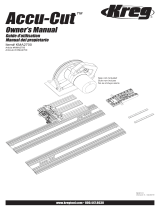 Kreg Accu-Cut User manual
Kreg Accu-Cut User manual
-
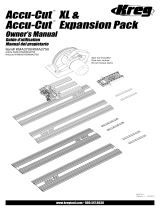 Kreg Accu-Cut Expansion Pack User manual
Kreg Accu-Cut Expansion Pack User manual
-
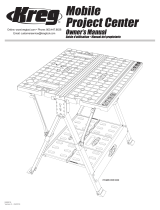 Kreg Mobile Project Center User manual
Kreg Mobile Project Center User manual
-
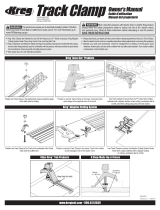 Kreg Track Clamp User manual
Kreg Track Clamp User manual
-
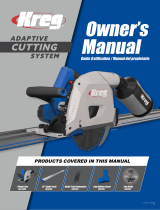 Kreg Adaptive Cutting System Plunge Saw User manual
Kreg Adaptive Cutting System Plunge Saw User manual
-
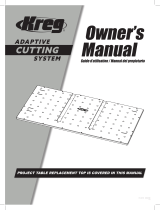 Kreg Adaptive Cutting System Project Table Replacement Top User manual
Kreg Adaptive Cutting System Project Table Replacement Top User manual
-
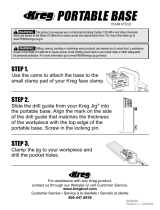 Kreg Portable Base User manual
Kreg Portable Base User manual
-
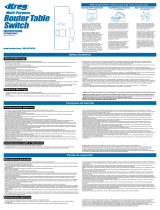 Kreg Multi-Purpose Router Table Switch User manual
Kreg Multi-Purpose Router Table Switch User manual
-
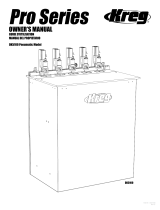 Kreg Panel-Boring Pocket Hole-Machine User manual
Kreg Panel-Boring Pocket Hole-Machine User manual
-
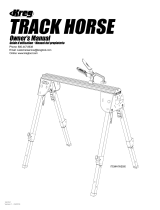 Kreg Track Horse User manual
Kreg Track Horse User manual





























